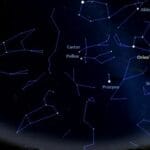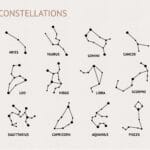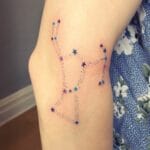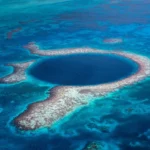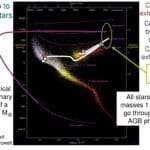Have you ever gazed at the Big Dipper and wondered what celestial wonders lie beyond? Ursa Major, home to this familiar asterism, acts as a celestial signpost, guiding us to a wealth of neighboring constellations. Join us on a cosmic journey, using the Big Dipper as our guide, to explore the eight constellations surrounding Ursa Major, uncovering hidden stars, ancient myths, and the secrets of navigating the night sky.
Exploring the Ursa Major Neighborhood
Ursa Major, the third largest constellation, sprawling across 1280 square degrees of the northern sky (NQ2, visible between +90° and -30° latitude), isn’t isolated in its celestial grandeur. It’s surrounded by a fascinating entourage of eight constellations, each a unique and captivating celestial entity. Let’s embark on a star-hopping adventure to meet these cosmic neighbors.
Eight Constellations Orbiting the Great Bear
Imagine Ursa Major as the bustling heart of a celestial city, with eight pathways radiating outwards, each leading to a distinct constellation.
Draco (The Dragon): North and northeast of Ursa Major, Draco slithers across the sky, a serpentine constellation resembling its namesake. This isn’t a fairytale dragon; it’s a celestial serpent winding its way among the stars. This constellation lies between Ursa Major and Ursa Minor, adding to the celestial narrative of the two bears. [https://www.lolaapp.com/orion’s belt big dipper]
Boötes (The Herdsman): East of Ursa Major, Boötes, the herdsman, stands as a celestial shepherd. Some cultures envision him eternally herding Ursa Major, the Great Bear, across the heavens. Boötes boasts Arcturus, a reddish-orange giant star and one of the brightest in the night sky, especially prominent during spring. [https://www.lolaapp.com/jupiter’s beard]
Canes Venatici (The Hunting Dogs): East and southeast of Ursa Major, these loyal canine companions trail Boötes, forever pursuing the Great Bear. They inject a sense of dynamic motion into this region of the sky.
Coma Berenices (Berenice’s Hair): Southeast of Ursa Major lies a delicate sprinkle of stars, resembling a soft, scattered cloud. This is Coma Berenices, a constellation whose story originates from a poignant human gesture – the sacrificed hair of an Egyptian queen. Its subtle beauty whispers a tale of devotion etched in the stars.
Leo (The Lion) & Leo Minor (The Smaller Lion): South of Ursa Major, a celestial pride prowls the night sky. Leo, a prominent member of the zodiac constellations, is easily recognized by Regulus, its bright heart. Nearby, the fainter Leo Minor requires a keener eye to discern.
Lynx (The Lynx): Southwest of Ursa Major, the elusive Lynx requires truly dark skies to reveal its faint form. Locating this constellation, appropriately named after the sharp-eyed feline, presents a challenge for the dedicated stargazer.
Camelopardalis (The Giraffe): Northwest of Ursa Major, Camelopardalis stretches gracefully, its long neck seemingly reaching for cosmic foliage. This large but faint constellation adds another intriguing character to Ursa Major’s celestial neighborhood.
Ursa Major: Your Celestial Compass
Ursa Major, particularly the Big Dipper, serves as more than just a familiar sight; it’s a celestial compass. Its pointer stars, Dubhe and Merak, guide us to Polaris, the North Star, in Ursa Minor. Following the arc of the Big Dipper’s handle, we “arc to Arcturus” in Boötes, and continuing further, we “spike to Spica” in Virgo. Ursa Major unlocks the night sky, making its neighboring constellations readily accessible.
Seasonal Variations and Celestial Shifts
The night sky is a dynamic canvas, constantly changing with the seasons. While Ursa Major is circumpolar for many in the Northern Hemisphere, visible year-round, the optimal viewing times for its neighbors vary. Embracing these seasonal shifts adds another layer of enjoyment to stargazing.
Myths and Legends Woven in Starlight
The constellations are not merely random points of light; they hold ancient tales of heroes, monsters, and deities. Ursa Major, often seen as a bear across cultures, and its neighbors each possess rich mythologies, enriching our stargazing experience and connecting us to humanity’s long history of interpreting the cosmos.
| Constellation | Location Relative to Ursa Major | Key Features/Stars | Mythology (Brief) |
|---|---|---|---|
| Draco | North/Northeast | Eltanin, Rastaban | Likely depicted the dragon Ladon, slain by Hercules in Greek mythology. |
| Boötes | East | Arcturus | Possibly associated with the inventor of the plow, eternally driving his oxen (represented by the Big Dipper) across the sky. |
| Canes Venatici | East/Southeast | Cor Caroli | Representing Boötes’ hunting dogs, these are relatively modern constellations. |
| Coma Berenices | Southeast | Diadem (faint star cluster) | Named for Queen Berenice II of Egypt, who probably sacrificed her hair for her husband’s safe return from war. |
| Leo | South | Regulus | Often identified as the Nemean Lion, another creature slain by Hercules. |
| Leo Minor | South | Praecipua | A fainter constellation with fewer prominent mythological connections. |
| Lynx | Southwest | Alpha Lyncis | Named for its faintness, as only those with lynx-like vision could perceive it. |
| Camelopardalis | Northwest | Beta Camelopardalis | A relatively recent addition, lacking the extensive mythology of older constellations. |
A Deeper Dive into the Cosmos
This is just the beginning. Each of Ursa Major’s neighbors offers a gateway to deeper exploration. Equip yourself with binoculars, a telescope, star charts, or astronomy apps, and embark on an extraordinary cosmic adventure.
Beyond the Big Dipper: Unveiling Ursa Major’s Surroundings
Ursa Major, marked by the prominent Big Dipper asterism, serves as a celestial landmark, a gateway to a region rich with constellations, galaxies, and deep-sky objects. Let’s venture beyond the familiar dipper shape and delve into this cosmic neighborhood.
Ursa Minor and the North Star
Ursa Minor, the Little Bear, is perhaps Ursa Major’s most renowned neighbor. These cosmic companions are linked by their bear-like names and shapes, and their positions in the sky. Ursa Minor houses Polaris, the North Star, a crucial navigational beacon for centuries. The Big Dipper’s pointer stars, Dubhe and Merak, act as a celestial arrow, pointing directly to Polaris.
A Constellation Collective
Beyond Ursa Minor, Ursa Major is surrounded by a captivating ensemble of constellations. Boötes, the Herdsman, with its bright orange star Arcturus, lies to the east. Draco, the Dragon, winds its way northward between the Big and Little Dippers. Camelopardalis, a faint but expansive constellation, also stretches towards the north celestial pole. Lynx and Leo add their distinct patterns to this celestial tapestry.
| Constellation | Description | Key Features |
|---|---|---|
| Draco | Winding, serpentine constellation | Lies between Ursa Major and Ursa Minor |
| Boötes | The Herdsman | Arcturus (bright orange star) |
| Camelopardalis | Large, faint constellation | Stretches towards the north celestial pole |
| Lynx | Dim, challenging constellation | Requires dark skies for visibility |
| Leo | Prominent spring constellation | “Sickle” asterism |
Galaxies Galore
This region isn’t just home to stars and constellations; it teems with galaxies, offering breathtaking views for amateur astronomers. M81, a grand spiral galaxy, and its interacting companion, M82, are relatively easy to find with a telescope. M101, the Pinwheel Galaxy, a face-on spiral similar to our Milky Way, presents a stunning display of spiral arms.
Star-Hopping with Ursa Major
Ursa Major acts as a celestial guide. Its pointer stars lead to Polaris and Ursa Minor. Following the arc of the Big Dipper’s handle leads to Arcturus in Boötes, and continuing this arc brings us to Spica in Virgo. This “arc to Arcturus, then spike to Spica” method is a time-honored technique for navigating the night sky.
Myths and Legends: Connecting to the Past
The constellations are steeped in mythology. Many cultures depict Ursa Major and Ursa Minor as bears. Some Native American traditions envision the Big Dipper as a bear pursued by hunters, with Ursa Minor’s fainter stars representing its cubs. These stories connect us to our ancestors and their interpretations of the cosmos.
While much is known about this region, ongoing research continues to unveil new information, potentially reshaping our understanding in the future. When you gaze upon Ursa Major, remember you’re looking at a gateway to a vast and dynamic universe.
Navigating the Celestial Space Between Ursa Major and Orion
The night sky is a vast and wondrous expanse, and the space between prominent constellations like Ursa Major and Orion is no exception. Rather than a single constellation occupying this space, it’s more like a celestial neighborhood with a shifting population. The constellations visible here depend on the time of year and your location on Earth, much like your view changes as you walk through a park.
Common residents of this cosmic neighborhood include Lynx, Gemini, Auriga, and Taurus. Their visibility changes throughout the year, creating a dynamic celestial vista.
Ursa Major: Your Starting Point
Ursa Major, especially the Big Dipper, is a valuable starting point for sky exploration. The pointer stars in the Big Dipper’s “bowl” guide us to Polaris, the North Star, located in Ursa Minor. From Polaris, you can navigate across the night sky using the time-tested technique of star-hopping.
Myths and Legends in the Sky
Adding another layer of fascination are the myths and legends associated with these constellations. Ursa Major is interpreted as a bear, wagon, or plow in different cultures. Orion, the mighty hunter of Greek mythology, adds another layer of storytelling to the celestial canvas.
Telescopic Treasures
Using a telescope opens up a new world of exploration. Within Ursa Major, galaxies like M81 and M82 await, offering glimpses into distant islands of stars. Nebulae, massive clouds of gas and dust, reveal the birthplaces and graveyards of stars.
While we continue to learn about the universe through ongoing research, much remains unknown. The constellations we see today might appear different in the distant future due to stellar movements. The space between constellations is as captivating as the constellations themselves, offering endless opportunities for discovery.
Decoding the Big Dipper in Ursa Major
The Big Dipper, that familiar ladle-shaped pattern in the night sky, is not a constellation itself, but an asterism within the larger constellation of Ursa Major, the Great Bear. It forms the bear’s tail and part of its hindquarters.
The Seven Stars of the Big Dipper
The Big Dipper comprises seven bright stars, each with an Arabic name:
| Star Name | Magnitude | Meaning | Notes |
|---|---|---|---|
| Alkaid | 1.85 | The Leader | Tip of the handle, bluish |
| Mizar | 2.04 | The Girdle | Double star with Alcor |
| Alioth | 1.76 | The Black Horse | Brightest star in Ursa Major |
| Megrez | 3.32 | The Root of the Tail | Connects handle to bowl, dimmest of the seven |
| Phecda | 2.41 | The Thigh | Bottom corner of the bowl |
| Merak | 2.34 | The Loin | Pointer star to Polaris |
| Dubhe | 1.79 | The Bear | Pointer star to Polaris, second brightest in Ursa Major |
Note the varying magnitudes, with Megrez noticeably dimmer than the others.
Ursa Major and Its Neighbors
Ursa Major, the third largest constellation, shares its celestial space with several others, including Draco, Boötes, Canes Venatici, Coma Berenices, Leo, Leo Minor, Lynx, and Camelopardalis.
The Big Dipper as Celestial Guide
The Big Dipper’s pointer stars, Merak and Dubhe, point directly towards Polaris, the North Star, providing a reliable way to find North and navigate the night sky.
Myths, Mysteries, and Ongoing Research
Constellations are interwoven with human history and mythology. Different cultures have projected their own stories onto these celestial patterns. Ongoing research continues to reveal new information about the stars of the Big Dipper and Ursa Major, adding to the ongoing story of these celestial objects.
- Crypto Quotes’ Red Flags: Avoid Costly Mistakes - June 30, 2025
- Unlock Inspirational Crypto Quotes: Future Predictions - June 30, 2025
- Famous Bitcoin Quotes: A Deep Dive into Crypto’s History - June 30, 2025

